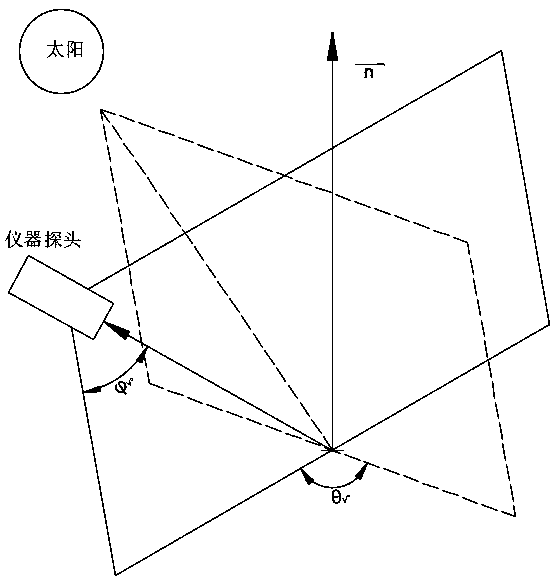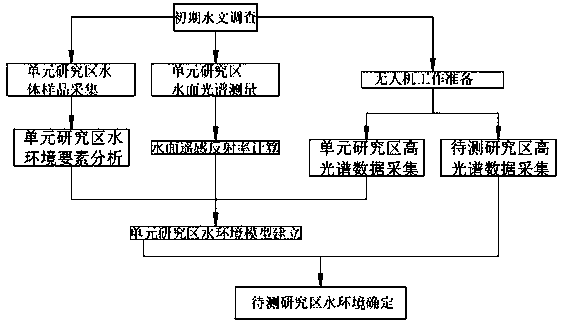Method for inverting estuarine wetland water environment elements through hyperspectral sensor on unmanned aerial vehicle
A hyperspectral, water environment technology, applied in the field of water environment simulation, can solve the problems of inability to obtain the content of water environment elements, inability to obtain inversion results, increase data redundancy, etc., to achieve large subjective initiative, predictive ability and robustness. The effect of strong performance and improved spatial resolution
- Summary
- Abstract
- Description
- Claims
- Application Information
AI Technical Summary
Problems solved by technology
Method used
Image
Examples
Embodiment 1
[0054] Example 1: Reference figure 1 ;
[0055] The method of inverting water environment elements of estuarine wetlands by using hyperspectral sensors on UAVs includes the following steps:
[0056] S1. The estuary wetland with a large area of tidal ditch is used as the study area to be tested, and the hydrological survey is carried out, and an appropriate small area of tidal ditch area is selected as the unit study area;
[0057] S2. Collection of water body samples in the unit study area; multiple groups of sampling points are arranged in the unit study area, and on the sampling points, water samples 0-0.5 meters below the water surface of the sampling points are collected by a water collector;
[0058] S3. Calculation of the water surface remote sensing reflectance of the unit study area; using the ground object spectrometer with reference to the spectral measurement method above the water surface to collect spectral data at the sampling point and calculate the water s...
Embodiment 2
[0092] In step S4, the water sample collected in step S2 is transferred to the laboratory for data analysis of water environment elements, including the determination of suspended matter mass, total salt content, determination of chlorophyll a concentration, and total nitrogen content. The measurement of total phosphorus content and the determination of total phosphorus content, etc.; take the water sample of group A to be tested and measure the suspended matter mass by "gravimetric method". The substance on the membrane is dried at 103°-105° and weighed to calculate the amount of suspended matter in the water sample; the water sample of group B to be tested is taken to measure the total salt content by the "gravimetric method", and a certain volume of water sample is passed through WhatmanGF / F filter membrane with a pore size of about 0.45μm is used for filtration and pretreatment, using a ceramic evaporating dish as a container, 0.1-0.2g anhydrous sodium carbonate as a dehydr...
Embodiment 3
[0093] Embodiment 3: In step S5, the flight preparations are first performed, and the flight route position and flight height are planned according to the area of the unit study area to ensure that the side overlap of adjacent flight zones reaches more than 50%. According to the flight height and the UAV hyperspectral sensor The parameter calculates the ground sampling distance; black (reflectivity 5%) and white (reflectivity 65%) non-woven fabrics are arranged in the flat and open area of the unit study area as dark and bright targets. This material has good Lambertian properties and can be used instead of The traditional diffuse reflection reference plate is used as the radiation calibration material; the size of the non-woven fabric must be at least 10 times larger than the ground sampling distance to ensure that it can be clearly identified in the image. According to the position of the navigation belt, 5 to 6 image control points are arranged around each air belt, and ...
PUM
 Login to View More
Login to View More Abstract
Description
Claims
Application Information
 Login to View More
Login to View More - R&D
- Intellectual Property
- Life Sciences
- Materials
- Tech Scout
- Unparalleled Data Quality
- Higher Quality Content
- 60% Fewer Hallucinations
Browse by: Latest US Patents, China's latest patents, Technical Efficacy Thesaurus, Application Domain, Technology Topic, Popular Technical Reports.
© 2025 PatSnap. All rights reserved.Legal|Privacy policy|Modern Slavery Act Transparency Statement|Sitemap|About US| Contact US: help@patsnap.com



